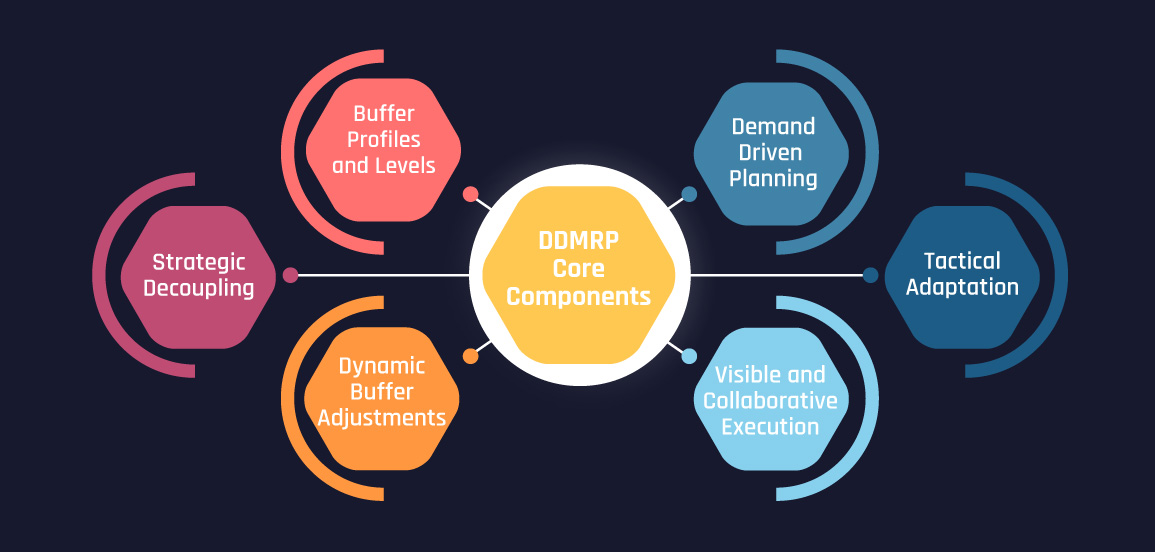Demand Driven Material Requirements Planning (DDMRP) is revolutionising the way businesses manage inventory and production in complex supply chains. Designed to adapt traditional Material Requirements Planning (MRP) to a demand-driven approach, DDMRP offers more flexibility and responsiveness by synchronising production with real customer demand. However, assessing the success of DDMRP requires more than just tracking inventory levels. Companies need a comprehensive set of advanced metrics to evaluate its performance across multiple dimensions, from lead time reduction to improved service levels.
This article covers key performance indicators (KPIs) and metrics that go beyond the basics to measure the full impact of DDMRP on a business’s supply chain. By exploring these metrics, companies can ensure their DDMRP implementation aligns with demand-driven principles, ultimately maximising the benefits of this innovative approach.
Understanding DDMRP: A Brief Overview
Before diving into the specific metrics, it’s essential to understand the core components of DDMRP. DDMRP combines elements from traditional MRP, Lean, and the Theory of Constraints, aiming to optimise inventory through strategic buffer placement and demand-driven execution. By focusing on actual customer demand rather than forecasts, DDMRP helps companies reduce lead times, lower inventory levels, and increase flexibility.
The framework involves six key steps:
- Strategic Decoupling: Identifying optimal points in the supply chain to hold strategic inventory buffers. These “decoupling points” act as shock absorbers, protecting against fluctuations in supply and demand. Careful placement minimises lead times and optimises inventory investment. DDMRP provides specific criteria to guide this strategic decision.
- Buffer Profiles and Levels: Each decoupled item is assigned to a buffer profile, a set of parameters that determine the size and behaviour of its inventory buffer. Profiles consider factors like lead times, variability, and product structure, simplifying the management of numerous items. Buffers are strategically sized to ensure decoupling points remain effective.
- Dynamic Buffer Adjustments: Recognizing the ever-changing nature of the business environment, DDMRP allows buffer sizes to adjust dynamically. Factors like demand fluctuations, lead time variations, and planned events (promotions, seasonality) trigger automatic adjustments, ensuring the system remains responsive.
- Demand Driven Planning: DDMRP utilises a unique set of rules, the “net flow equation,” to generate supply orders. This equation considers actual demand signals and buffer levels to determine the appropriate order quantities, ensuring replenishment aligns with real-time needs.
- Visible and Collaborative Execution: DDMRP distinguishes between planning and execution. Once planned orders are confirmed, the focus shifts to execution, with real-time alerts highlighting potential disruptions to flow. This visibility promotes proactive problem-solving and collaboration across the supply chain.
- Tactical Adaptation: The final component focuses on continuous improvement. Demand Driven Sales and Operations Planning (DDS&OP) analyses past performance and future expectations to fine-tune the DDMRP model. This includes adjusting decoupling points, buffer profiles, and planning parameters, ensuring the system remains optimised over time.

Why Advanced Metrics Matter for DDMRP Success
Tracking inventory levels alone provides only a narrow view of DDMRP’s (Demand Driven Material Requirements Planning) effectiveness. While some executives implement DDMRP with the aim to optimise inventory, its ultimate goal is to improve the entire supply chain’s responsiveness to real customer demand. To truly gauge the impact of DDMRP, businesses must look beyond basic inventory metrics and incorporate advanced indicators that align with broader supply chain objectives.
Advanced metrics allow companies to assess the deeper value DDMRP brings to their operations. For example, lead time reduction metrics can reveal whether DDMRP is successfully decreasing the time it takes to fulfil orders, directly impacting customer satisfaction. Similarly, tracking stockout frequency and fill rates provides insight into how well DDMRP is helping maintain optimal service levels and avoid costly inventory shortages. By focusing on order variability and stability, companies can evaluate the consistency of their operations, ensuring that DDMRP reduces fluctuations that can disrupt production and increase costs.
Moreover, advanced metrics highlight areas where DDMRP might need refinement. For example, if order fulfilment remains low, it could indicate that buffer levels aren’t optimally set to cope with variability, or that there are underlying issues in operations capacity. These metrics help pinpoint specific areas for improvement, guiding adjustments to enhance DDMRP’s effectiveness further.
By embracing a comprehensive set of metrics, companies can better understand how DDMRP impacts their supply chain as a whole. Advanced metrics provide a clear picture of DDMRP’s value, allowing businesses to adapt more quickly to customer demand shifts, reduce costs, and ultimately build a more resilient, demand-driven supply chain. In today’s dynamic markets, this holistic approach to performance measurement is essential for sustaining competitive advantage and ensuring DDMRP success.
Key Performance Indicators (KPIs) for DDMRP Success
Let’s delve into the critical KPIs for measuring DDMRP success, emphasising metrics that go beyond inventory levels.
Lead Time Reduction
Lead time is a fundamental metric in any supply chain, and DDMRP’s ability to reduce lead times is one of its greatest strengths. By positioning buffers closer to demand sources, DDMRP reduces the time needed to fulfil orders.
- Pre-Implementation vs. Post-Implementation Lead Time: Track lead times before and after DDMRP adoption to quantify improvements.
- Average Order Fulfilment Time: Measure the average time taken from receiving an order to delivering the product to the customer.
- Lead Time Variability: This metric evaluates the consistency of lead times, which directly impacts service levels and customer satisfaction.
Reducing lead time not only boosts customer satisfaction but also reduces the risk of stockouts and excess inventory, ensuring a leaner, more efficient supply chain.

Inventory Turnover Rate
DDMRP’s strategic buffer positioning helps optimise inventory levels, which can be observed through changes in inventory turnover rate.
- Inventory Turns: Calculate the number of times inventory is sold or used in a given period. A higher inventory turnover rate generally indicates more efficient inventory management.
- Days of Inventory on Hand (DOH): DOH reflects how long current stock levels can meet demand without replenishment. Lower DOH post-DDMRP implementation suggests improved inventory efficiency.
Tracking these metrics helps companies assess whether DDMRP is successfully minimising inventory without compromising service levels.

Stockout Frequency and Fill Rate
Stockouts lead to lost sales and customer dissatisfaction. DDMRP aims to prevent stockouts by dynamically adjusting buffer levels based on demand shifts.
- Stockout Frequency: Measure the frequency of stockouts before and after DDMRP implementation.
- Fill Rate: Calculate the percentage of customer demand met without delay. A high fill rate signifies improved service levels and reduced stockout frequency.
Both stockout frequency and fill rate provide insights into DDMRP’s effectiveness in maintaining optimal inventory levels and ensuring customer satisfaction.

Order Variability and Order Stability
A key objective of DDMRP is to achieve a stable and responsive supply chain that minimises order variability.
- Order Variability: This metric assesses fluctuations in order quantities over time. By reducing order variability, DDMRP creates a more stable supply chain that can respond to demand without excessive inventory.
- Order Stability Index (OSI): The OSI measures the consistency of orders over time, indicating whether DDMRP is successfully reducing order changes and last-minute adjustments.
Reduced order variability and improved stability directly contribute to cost savings and operational efficiency.

Advanced Metrics for DDMRP Alignment with Demand-Driven Principles
Beyond core KPIs, advanced metrics allow companies to evaluate how well DDMRP aligns with demand-driven principles.
Forecast Accuracy Improvement
Although DDMRP relies on actual demand rather than forecasts, forecast accuracy remains important for long-term planning and capacity management.
- Forecast Accuracy Ratio: Measure how accurately forecasted demand matches actual demand over a set period.
- Forecast Bias: Calculate any consistent over- or underestimation in forecasts. Lower forecast bias indicates better alignment with demand-driven principles.
Improved forecast accuracy supports proactive capacity planning and helps mitigate demand fluctuations.

Demand Variability Absorption
One of DDMRP’s strengths is its ability to absorb demand variability without excessive inventory or disruptions.
- Demand Flexibility Index (DFI): DFI quantifies the ability of a supply chain to adapt to shifts in demand without affecting inventory levels or lead times.
- Buffer Utilisation Rate: Measure the percentage of buffer usage to track how well buffers absorb variability.
High DFI and efficient buffer utilisation indicate that DDMRP is achieving its goal of flexibility and responsiveness.

Supplier Performance Metrics
Since DDMRP impacts the entire supply chain, it’s important to track supplier-related metrics.
- Supplier Lead Time Consistency: Monitor how consistent supplier lead times are, as variability here can impact buffer effectiveness.
- On-Time Delivery Rate: Measure the percentage of orders delivered on time by suppliers to evaluate the reliability of the upstream supply chain.
Good supplier performance supports the effectiveness of DDMRP and ensures a more resilient supply chain.

Adapted Traditional Metrics for DDMRP Evaluation
Traditional supply chain metrics can also be adapted to better reflect DDMRP principles. These adapted metrics focus on responsiveness, flexibility, and customer-centricity.
Adapted Service Level Metrics
DDMRP emphasises customer satisfaction, making service levels critical for assessing success.
- Customer Response Time: Track the time it takes to respond to customer orders, focusing on improvements post-DDMRP.
- Service Level Achievement (SLA) Rate: Measure the percentage of times the business meets predefined service levels.
Higher service level achievement rates indicate that DDMRP is delivering on its promise of better customer responsiveness.

Cost-to-Serve Analysis
Cost-to-serve calculates the total cost incurred to meet customer demand, including production, inventory, and distribution costs.
- Cost-to-Serve Reduction: Track the decrease in cost-to-serve post-DDMRP implementation. Lower costs indicate that DDMRP is effectively optimising inventory and production.
- Transportation Cost per Unit: As DDMRP reduces last-minute orders, transportation costs should also decrease, reflecting more efficient logistics.
By reducing the cost-to-serve, companies can achieve a leaner, more profitable supply chain.

Capacity Utilisation Metrics
Capacity utilisation measures how effectively resources are used, which DDMRP can enhance by stabilising production schedules.
- Average Capacity Utilisation Rate: Track the percentage of utilised capacity over a period. Higher utilisation without overloading resources signifies better efficiency.
- Capacity Flexibility Index (CFI): CFI measures the ability to ramp up or scale down production in response to demand changes.
Better capacity utilisation and flexibility demonstrate the success of DDMRP in balancing demand with production capabilities.

Continuous Improvement and DDMRP Refinement
DDMRP (Demand Driven Material Requirements Planning) is designed to adapt and evolve with changing demand patterns, and the use of continuous improvement practices is critical to achieving its full potential. By regularly analysing key metrics such as lead time reduction, stockout frequency, and order variability, companies can identify specific areas where their DDMRP strategy could be enhanced. These metrics provide essential insights into how well DDMRP is aligning with business goals and highlight opportunities for refinement.
Root Cause Analysis of Variability
When significant fluctuations or unexpected trends appear in DDMRP metrics, root cause analysis becomes crucial. For instance, if stockouts become more frequent or lead times start to increase, it could signal underlying issues like production bottlenecks, inaccurate forecasts, or supplier delays. By investigating these variations, businesses can uncover specific issues within the supply chain. Addressing these root causes not only resolves immediate challenges but also strengthens the supply chain against future disruptions. Root cause analysis thus ensures that DDMRP continuously improves in its ability to adapt to demand.
Regular Benchmarking
Benchmarking DDMRP performance against industry standards or historical company data enables businesses to evaluate the effectiveness of their DDMRP strategy on a broader scale. By comparing metrics like order stability or inventory turnover with industry averages or past performance, companies gain a clearer understanding of their competitive positioning. Benchmarking can also reveal trends in customer demand, helping the business stay responsive to market shifts. Regularly updating benchmarks encourages continuous improvement and helps maintain DDMRP’s alignment with evolving customer needs.
By leveraging root cause analysis and benchmarking, companies can ensure that their DDMRP processes remain dynamic and adaptable. This focus on continuous improvement enhances DDMRP’s ability to optimise the supply chain, ultimately supporting sustainable, demand-driven growth.
Conclusion: The Road to DDMRP Success
Measuring DDMRP success requires a comprehensive approach, going beyond basic inventory metrics to assess lead times, order stability, and demand variability absorption. By tracking these advanced metrics, businesses can fully evaluate the impact of DDMRP, ensuring it aligns with demand-driven principles and meets customer expectations.
Implementing DDMRP is an ongoing journey that requires continuous improvement. With the right metrics in place, companies can optimise their supply chains, reduce costs, and ultimately achieve a resilient, customer-focused operation that thrives in today’s dynamic market.
Discover the key performance indicators that will help you measure the true impact of DDMRP on your supply chain.







